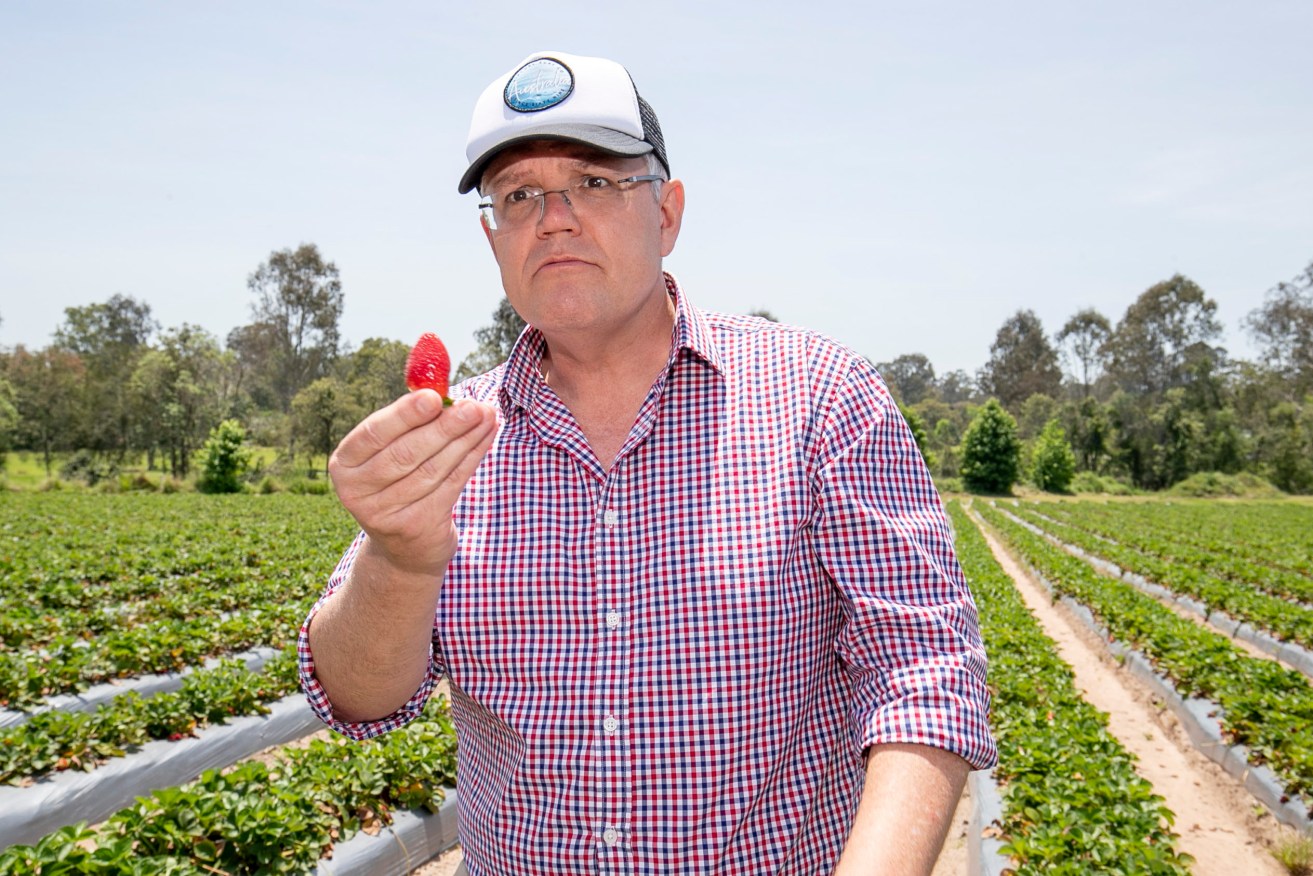Stopping the rot: Incentives on table as farmers desperate to fill 26,000 harvest jobs
Unemployed young people could soon be offered extra cash incentives to help with the harvest season.

Australia's Prime Minister Scott Morrison is seen during a visit to a strawberry farm in Chambers Flat in southeast Queensland. (Photo: AAP Image/Tim Marsden)
Australia’s fruit and vegetable farmers need an extra 26,000 workers to harvest their crops this summer, according to new research illustrating the impact of coronavirus border closures on farm labour.
The report, from consultancy firm Ernst & Young (EY), is the first to quantify the worker shortfall in the farm sector, which is typically reliant on overseas workers, since Australia closed its borders in March.
It was commissioned by industry group Hort Innovation, and farm groups say it proves the need for governments to intervene to ensure produce is not wasted and food supply is not disrupted.
The demand for seasonal workers to harvest and pack produce will peak in March next year.
Queensland provides two of the regions the EY report says demand for labour is likely to be greatest. They are:
Cairns
Wide Bay
Southeast South Australia
Shepparton
Northwest Victoria
Coffs Harbour and Grafton
The NSW Murray region
Agriculture Minister David Littleproud has already announced a range of changes aimed at plugging the gaps.
Jobseekers can earn $300 a fortnight without affecting their welfare payments.
Backpackers working on farms can stay with one employer for more than six months and stay in Australia an extra year.
Programs aimed at bringing in Pacific and Timorese workers to fill rural and regional job shortages have reopened.
The Prime Minister has signalled he will do more to open the seasonal labour schemes and encourage Australians to take up regional jobs.
Mr Littleproud said he was working closely with farmers on additional measures ahead of next week’s federal budget.
“Farmers don’t have the luxury of sitting around waiting for workers to turn up and we don’t want fruit rotting on the vine or crops left in the field,” he told AAP on Wednesday.
The National Farmers’ Federation (NFF), which warned of labour shortages pre-COVID 19 and has previously lobbied for an agriculture-specific visa to address worker shortages, said the EY report proved the need for urgent intervention.
“Governments often tell the farm sector to ‘show us the data’ on the industry’s labour deficit, well, here it is,” NFF chief executive Tony Mahar said.
“The numbers are alarming and must be a catalyst to governments — state and federal.”
AusVeg spokesman Tyson Cattle hoped governments would see the report as “a lightbulb moment”.
“They’ve been calling for data and evidence on understanding the shortage, and 26,000 workers is not a small amount,” Cattle said.
“We’re just looking at any option and happy to work with Government for any option to get people on-farm, because at the moment its desperate times for a lot of growers and they just need a workforce.”
Cattle said many growers were now making difficult decisions
“They’re reassessing their harvest and whether they plant the next crop, and all those things that will flow on to the consumer essentially,” he said.
Last month, 163 workers from Vanuatu were permitted to enter the Northern Territory to work on mango farms under a seasonal worker trial.
Several farm groups have been calling for an urgent extension of the program, and are seeking incentives to help displaced workers in Australia join the horticulture workforce.
At a media conference in Canberra on Tuesday, Prime Minister Scott Morrison said he was open to soon expanding the seasonal and Pacific worker programs, but did not elaborate.
The EY report comes as Australia’s domestic unemployment rate is expected to reach 10 per cent.
Some growers have raised concerns that increased welfare payments for out-of-work Australians are deterring unemployed people from seeking jobs on farms.
But less than one-fifth of the 450 growers that responded to the EY survey believed the domestic unemployment would affect the labour supply.
Up until last week, JobSeeker for a single person with no dependents was $1,115 per fortnight, which EY compared to the horticulture award, which paid $1980 based on an 80-hour fortnight.
JobSeeker payments were wound back this week, with the rate for a single person with no dependents falling to $815 per fortnight.
EY reported that COVID-19 had caused unprecedented disruption to the global labour market.
It said France expected a 200,000 casual worker shortage over three months, while just a quarter of the 60,000 casual labourers needed in England were expected to arrive in the UK this year and 100,000 farm workers could be hindered by restrictions in Italy.
The report was based on an assumption that international borders would reopen in March next year, and noted that if that was not the case, the labour shortage would likely grow.
-AAP












